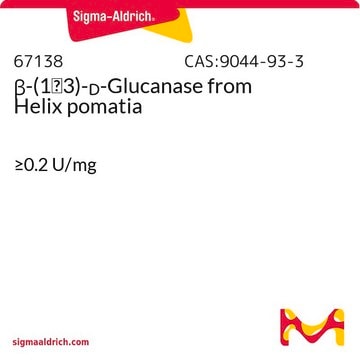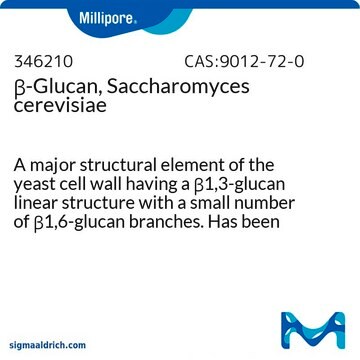49101
β-Glucanase from Aspergillus niger
powder, dark brown, ~1 U/mg
Sign Into View Organizational & Contract Pricing
All Photos(2)
About This Item
Recommended Products
form
powder
specific activity
~1 U/mg
greener alternative product characteristics
Waste Prevention
Design for Energy Efficiency
Learn more about the Principles of Green Chemistry.
sustainability
Greener Alternative Product
color
dark brown
greener alternative category
storage temp.
2-8°C
Related Categories
General description
We are committed to bringing you Greener Alternative Products, which adhere to one or more of The 12 Principles of Greener Chemistry. This product has been enhanced for energy eficiency and waste prevention when used in cellulosic ethanol research. For more information see the article in biofiles.
Biochem/physiol Actions
β-glucanases degrade β-1,4-glucans of cellulose, xyloglucan and β-1,4-xylan.
Unit Definition
One unit corresponds to the amount of enzyme which will release 1 μmole of reducing sugar equivalents (expressed as glucose) per minute at pH 5.0 and 55 °C, using β-D-glucan (Cat. No. 49102) as substrate
Signal Word
Danger
Hazard Statements
Precautionary Statements
Hazard Classifications
Resp. Sens. 1
Storage Class Code
11 - Combustible Solids
WGK
WGK 1
Flash Point(F)
Not applicable
Flash Point(C)
Not applicable
Personal Protective Equipment
dust mask type N95 (US), Eyeshields, Gloves
Certificates of Analysis (COA)
Search for Certificates of Analysis (COA) by entering the products Lot/Batch Number. Lot and Batch Numbers can be found on a product’s label following the words ‘Lot’ or ‘Batch’.
Already Own This Product?
Find documentation for the products that you have recently purchased in the Document Library.
Customers Also Viewed
Jian-Wen Huang et al.
Applied microbiology and biotechnology, 94(1), 111-121 (2011-10-01)
1,3-1,4-β-D-Glucanase has been widely used as a feed additive to help non-ruminant animals digest plant fibers, with potential in increasing nutrition turnover rate and reducing sanitary problems. Engineering of enzymes for better thermostability is of great importance because it not
C J O'Shea et al.
Journal of animal science, 88(4), 1411-1420 (2009-12-22)
The objective of the current experiment was to evaluate the influence of dietary cereal sources of beta(1,3)(1,4)-d-glucan (beta-glucan) and enzyme supplementation on indices of environmental pollution from finisher pigs. An experiment with a 2 x 2 factorial arrangement of treatments
Qin Guo et al.
Journal of Zhejiang University. Science. B, 11(1), 41-51 (2010-01-01)
The aim of this work was to construct a novel food-grade industrial arming yeast displaying beta-1,3-1,4-glucanase and to evaluate the thermal stability of the glucanase for practical application. For this purpose, a bi-directional vector containing galactokinase (GAL1) and phosphoglycerate kinase
Pengjun Shi et al.
Applied and environmental microbiology, 76(11), 3620-3624 (2010-04-13)
Xylanases are utilized in a variety of industries for the breakdown of plant materials. Most native and engineered bifunctional/multifunctional xylanases have separate catalytic domains within the same polypeptide chain. Here we report a new bifunctional xylanase (XynBE18) produced by Paenibacillus
Meike Spexard et al.
Biotechnology letters, 32(2), 243-248 (2009-10-10)
The extracellular production of a hybrid bacterial beta-glucanase using Escherichia coli was studied by using combinations of promoters of varying strength for both a beta-glucanase as the target protein and the Kil protein as the releasing factor. Four strains with
Our team of scientists has experience in all areas of research including Life Science, Material Science, Chemical Synthesis, Chromatography, Analytical and many others.
Contact Technical Service







